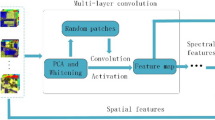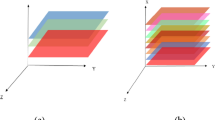Abstract
It is of great significance and practical application value to extract land-cover type accurately. However, the input data usually used in classification such as reflectance data or vegetation index are very simple and quantitative remote sensing products are rarely used. In this paper, a multi-spectral land-cover classification method based on deep learning is proposed. Using the excellent detail capture ability of contourlet transform to obtain the potential information to supplement the spectral feature space, combined with deep learning for feature selection and feature extraction, a spectral–texture classification model is constructed. The multi-spectral sensing remote data and field measurement data in Dadukou District of Chongqing, northern Negev, and Changping region of Beijing were used for evaluation. Experiment results show the proposed method can outperform principal component analysis, linear discriminant analysis and neural network, and effectively improve the classification accuracy of multi-spectral images; this method provides a new perspective for land-use classification.








Similar content being viewed by others
References
Alvarez-Mieles G, Lrvine K, Griensven A (2013) Relationships between aquatic biotic communities and water quality in a tropical river-wetland system. Environ Sci Policy 5(3):1–13
Gao XG, Wang L, Qi DH (2013) Eco-Security evaluation of wetland based on PSR model-taking Dashanbao wetland as an example. J Nat Sci Human Normal Univ 36(2):86–90
He TD, Zhao KL (2018) Multispectral remote sensing land use classification based on RBF neural network with parameters optimized by genetic algorithm. Int Conf Sensor Netw Signal Process (SNSP) 8:118–123
Kaya GT, Ersoy OK, Kamasak ME (2011) Support vector selection and adaptation for remote sensing classification. IEEE Trans Geosci Remote Sens 49(6):2071–2079
Diao W, Sun X, Zheng X et al (2016) Efficient saliency-based object detection in remote sensing images using deep belief networks. IEEE Geosci Remote Sens Lett 13(2):137–141
Lv Q, Dou Y, Niu X, et al (2014) Classification of land cover based on deep belief networks using polarimetric RADARSAT-2 data. In: Proceedings of Geoscience and Remote Sensing Symposium, pp 4679–4682
Do MN, Vetterli M (2002) Contourlets: a directional multi resolution image representation. In: IEEE ICIP, pp 357–360
Tian B, Xiong WZ (2018) A side information generation method using deep learning for distributed video coding. J Phys Conf Ser 6(5):210–223
Shankar B, Meher Saroj K, Ghosh Ashish (2011) Wavelet-fuzzy hybridization: feature extraction and land-cover classification of remote sensing images. Appl Soft Comput 11:2999–3011
Lecun Y, Bottou L, Bengio Y et al (2014) Gradient-based learning applied to document recognition. Proc IEEE 86(11):2278–2324
Qu F, Zhang JT, Shao ZT, Qi SZ (2017) An intrusion detection model based on deep belief network. In: International Conference on Network, Communication and Computing, vol 77, pp 15–27
Huang Hai B, Huang Xiao R, Li Ren X, Teik C (2016) Sound quality prediction of vehicle interior noise using deep belief networks. Appl Acoust 35(12):1–12
Bengio Y, Lamblin P, Dan P et al (2006) Greedy layer-wise training of deep networks. In: Proceedings of International Conference on Neural Information Processing Systems. MIT Press, Cambridge, pp 153–160
Liu L, Sun WW, Ding B (2016) Offline handwritten Chinese character recognition based on DBN fusion model. In: IEEE International Conference on Information and Automation, pp 1911–1918
Fan X, Peter WT (2018) Combined deep belief network in deep learning with affinity propagation clustering algorithm for roller bearings fault diagnosis without data label. J Vib Control 34(1):1–26
Niu X, Ban YF (2014) A novel contextual classification algorithm for multitemporal polarimetric SAR data. IEEE Geo-sci Remote Sens Lett 11(3):681–685
Burt PJ, Adelson EH (2013) The Laplacian pyramid as a compact image code. IEEE Trans Commun 31(4):532–540
Bamberger RH, Smith MT (2002) A filter bank for the directional decomposition of images: theory and design. IEEE Trans Signal Proc 40(4):882–893
Mahdianpari M, Salehi B, Rezaee M, Mohammadimanesh F, Zhang Y (2018) Very deep convolutional neural networks for complex land cover mapping using multispectral remote sensing imagery. Remote Sens 10:1119. https://doi.org/10.3390/rs10071119
Zhang P, Ke Y, Zhang Z, Wang M, Li P, Zhang S (2018) Urban land use and land cover classification using novel deep learning models based on high spatial resolution satellite imagery. Sensors 18:3717. https://doi.org/10.3390/s18113717
Li C, Wang Y, Zhang X, Gao H, Yang Y, Wang J (2019) Deep belief network for spectral-spatial classification of hyperspectral remote sensor data. Sensors 19:204. https://doi.org/10.3390/s19010204
Li J, Xi B, Li Y, Du Q, Wang K (2018) Hyperspectral classification based on texture feature enhancement and deep belief networks. Remote Sens 10:396. https://doi.org/10.3390/rs10030396
Gaetano R, Ienco D, Ose K, Cresson R (2018) A two-branch CNN architecture for land cover classification of PAN and MS imagery. Remote Sens 10:1746. https://doi.org/10.3390/rs10111746
Acknowledgements
This research work has been partially supported by National Science Foundation of China under Grant No. 41371338.
Author information
Authors and Affiliations
Corresponding author
Additional information
Publisher's Note
Springer Nature remains neutral with regard to jurisdictional claims in published maps and institutional affiliations.
Rights and permissions
About this article
Cite this article
He, T., Wang, S. Multi-spectral remote sensing land-cover classification based on deep learning methods. J Supercomput 77, 2829–2843 (2021). https://doi.org/10.1007/s11227-020-03377-w
Published:
Issue Date:
DOI: https://doi.org/10.1007/s11227-020-03377-w




